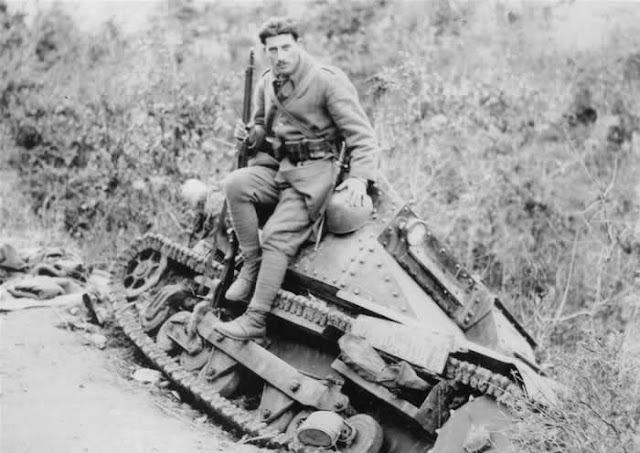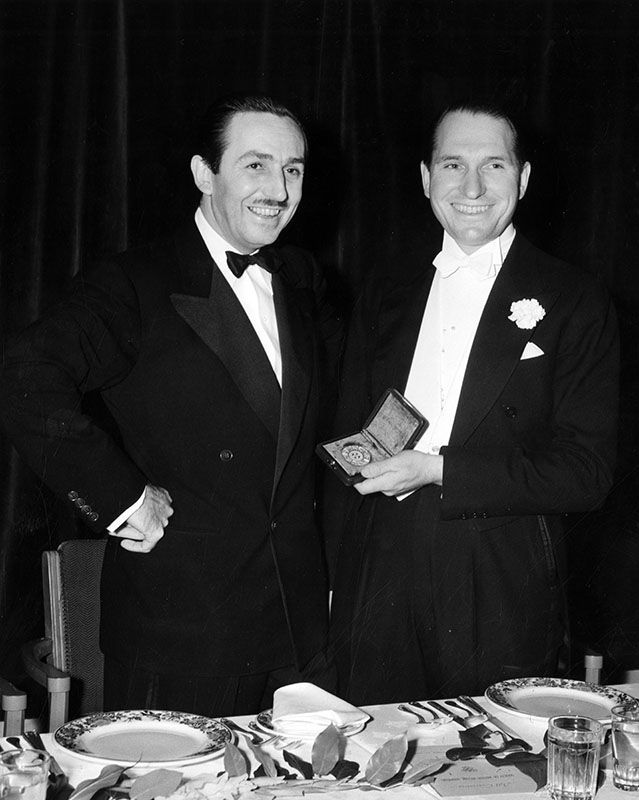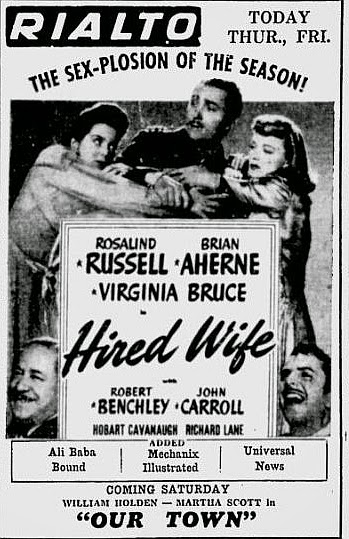Sunday 3 November 1940
 |
| Greek soldier on an Italian L3/33 tankette during the Battle of Elaia. |
On the Kalpaki front in the Negrades sector, the Albanian battalion which seized the Grabala heights on the 2nd is forced off of it and the Greeks re-occupy the hill. This is the start of a seesaw battle for possession of the heights which is to the Greeks' advantage, as it is keeping the Italians penned into a restricted area and preventing re-allocation of forces to more strategically significant areas.
The Italians bomb Salonika again.
The British, with the approval of the Greek government, begin landing troops in the Peloponnese (west of Athens). A British tanker docks at Piraeus, the port of Athens, permitting the transfer of RAF units to mainland Greece.
European Air Operations: The weather is poor, so the Luftwaffe bombers stay in their bases throughout the night. It is the first night with no bombing of London after 57 straight nights. The average attack during that time was 165 planes dropping 13,600 tons of high explosives and additional incendiary bombs. Many people are now basically living in the subway system and thus their routine alters little.
RAF Bomber Command attacks the dockyards at Kiel and oil installations/railway targets in Naples, Italy. The latter attacks are mounted from Malta.
The South African Air Force shoots down two Italian bombers over Kenya.
Wilfrid Rhodes Freeman, 1st Baronet, moves from RAF Research and Development to become Vice-Chief of the Air Staff. Lord Beaverbrook replaces him (with eventually poor results). Freeman is opposed to this staffing change, but it is the first of a series of related changes in the RAF high command. Freeman has been the research and development guy most responsible for the development of the Hawker Hurricane, Supermarine Spitfire, De Havilland Mosquito, Avro Lancaster, Handley-Page Halifax, and Hawker Tempest, as well as the P-51 Mustang Fighter. He is one of the most far-sighted and insightful men in the RAF. While it is an institutional decision, the decision to replace the Mustang's Allison V-1710 engines with the Rolls-Royce Merlin engine essentially flows from his desk. Freeman is one of those unsung heroes that set the stage for all the war heroes to take their bows, while nobody remembers his name.
 |
| Air Chief Marshal Sir Wilfrid Freeman. |
U-99 torpedoes independent 5376-ton British banana boat Casanare around 21:40 (the British love their bananas, no joke). It is a rather ordinary attack, but it leads to something much greater. Independents (unescorted ships not in convoys) are easy prey for U-boats because the U-boats don't have to be worried about being spotted and attacked, so they can set up the target at their leisure. They also can serve another, larger purpose to a U-boat, which Kretschmer proceeds to demonstrate like a professor in the classroom.
The Casanare takes its time sinking, which provides nice bait for Kretschmer's real prey. If you put out some cheese, you never know how many mice may show up. Casanare manages to get a distress call out and waits for rescue. It is sinking slowly, completely defenseless and an obvious target, but Kretschmer bides his time. Armed Merchant Cruiser (AMC) HMS Laurentic (F 51) (Capt E.P. Vivian) picks up the distress message. The Laurentic is an 18,724 ton White Star ocean liner converted into an auxiliary cruiser, which involves some changes to the superstructure and addition of various weapons such as guns and depth charges. Conversion, however, does not make an AMC any more difficult to sink. Joining the Laurentic is 11,314 ton HMS Patroclus (Capt. G.C. Wynter), another AMC. The two AMCs arrive on the scene quickly, by 22:50.
 |
| Kretschmer and his crew enjoy some libations right around the time of this patrol in 1940. |
Kretschmer, meanwhile, brazenly is keeping his U-boat on the surface in the darkness. A lookout on the Laurentic spots it and the slowly sinking liner opens fire with its deck guns. Slinking away in the darkness, Kretschmer decides to pay the Patroclus a visit. Absorbed in picking up men from the water, this AMC's crew does not notice U-99 sneaking up on it either. Kretschmer maneuvers to within 300 meters and fires a torpedo into the Patroclus at 00:22 on the 4th, which again does not cause it to sink immediately. All three British surface ships are now dead in the water and helpless. Kretschmer now maneuvers around them, casually pumping another torpedo into the Patroclus at 00:44 and then another at 01:18. The gunners on the Patroclus spot U-99 and fire at it, but once again Kretschmer slinks away in the darkness. All three ships are sinking, but taking their sweet time about it.
Kretschmer once again bides his time. The AMCs get off distress messages of their own, which draws a Short Sunderland flying boat at 02:39 which overflies the scene and forces U-99 to submerge. The Casanare eventually sinks, but the two AMCs are more solidly built and remain afloat for the time being. However, they aren't going anywhere. At 03:30, Kretschmer resurfaces and surveys the scene. He waits, then at 04:35 he casually approaches to within 250 meters of the Laurentic and pumps another torpedo into it just to hurry it along. This torpedo does the trick, hitting the stern and setting off its depth charges. The Laurentic sinks quickly by the stern.
By this time, more Royal Navy units are approaching, as is daylight. Kretschmer pumps two more torpedoes into the Patroclus, the last at 05:25 which sinks the ship quickly. Royal Navy destroyers HMS Hesperus (H 57, Lt.Cdr. D.G.F.W. Macintyre) and HMS Beagle (Lt. C.R.H. Wright) arrive on the scene. Hesperus forces Kretschmer to submerge while Beagle picks up survivors.
In total, there are:
- 54 survivors and 9 deaths on the Casanare;
- 368 survivors and 49 deaths on the Laurentic;
- 263 survivors and 56 deaths on the Patroclus.
 |
| U-99, 1940. |
The Luftwaffe attacks Convoy WN 29 in the North Sea east of Fraserburgh, Aberdeenshire. Heinkel He 115 seaplanes of KG 706 bomb and sink 3877-ton British freighter Kildale. There are 1-8 deaths as a result of the attack out of the 37-man crew (sources vary).
The same Luftwaffe attack that sank the Kildale also torpedoes and damages 5888-ton British refrigerated fruit carrier Eros in the same general location. The Eros previously had been torpedoed and damaged by U-48 on 7 June 1940, but put back into service. The Eros survives this attack as well, later repaired and returned to service. It is a lucky ship, perhaps because of the natural buoyancy of its construction.
A Luftwaffe Focke Wulf Fw 200 Condor also damaged 19,141-ton British freighter Windsor Castle near Scotland. It manages to return to the Clyde.
Royal Navy submarine HMS Sturgeon (Lt.Cdr. D. St Clair Ford) torpedoes and damage 1337 ton Danish freighter Sigrun in Oslofjord about 19 km southeast of Larvik, Norway.
Belgian 132-ton fishing trawler Van der Weyden hits a mine (apparently) and sinks off Milford Haven, Pembrokeshire. There is one survivor and eight deaths. The boat rests in shallow water.
British 394 ton freighter Cairngorm hits a mine and is damaged in the Bristol Channel.
Some sources say that British 1535 ton coaster Hilfern sinks today in the North Sea off Fraserburgh, Aberdeenshire due to an explosion, probably a mine. Other sources say it occurred on 31 October, which is where we have it.
German freighter Helgoland, which has left Colombian waters in a risky bid to make it to France, passes St. Thomas of the US Virgin Islands. It so far has eluded the Neutrality Patrol vessels which have been alerted to its voyage.
Convoy FN 326 departs from Southend, Convoy FS 327 departs from Methil,
 |
| The Eros in the Clyde. |
German Military: General von Thoma, just back from an inspection tour of Libya, briefs Hitler on the state of Italian forces there. He reports that the Italians were hostile to him, are inadequate to their mission, and do not want German troops in North Africa. He also comments on the supply difficulties faced in North Africa. Hitler will use this information during a major OKW meeting scheduled for the 4th.
US Military: General George S. Patton, Jr. becomes acting commander of the 2nd US Armored Division.
Heavy cruiser USS Louisville departs Montevideo, Uruguay for Buenos Aires on its "Show the Flag" mission.
Rear Admiral John W. Greenslade concludes his talks with French Vice-Admiral Georges A.M.J. Robert. In exchange for Greenslade recommending a relaxation of sanctions on the Vichy territory, the French will permit daily patrol plane overflights.
Guam: A typhoon hits the Mariana Islands. The Congress, with some internal opposition, has spent millions of dollars upgrading US naval facilities there, and they are badly damaged. The US Navy Yard at Piti, the nearby Marine Barracks, and nearby farms and residences are all hit hard. A district patrol craft (YP-16 or YP-17) sinks dredge YM-13 (being used to enlarge the channel for naval use) is blown ashore, Greek freighter Axios is blown off her moorings and barely escapes being wrecked on the nearby reefs. Fortunately, the islanders themselves have been through this before and carry on, helping to repair as much damage as they can.
November 1940
November 1, 1940: Hitler Irate
November 2, 1940: U-31 Sunk - Again
November 3, 1940: Kretschmer's Master Class
November 4, 1940: Spain Absorbs Tangier
November 5, 1940: Jervis Bay Meets Admiral Scheer
November 6, 1940: San Demetrio Incident
November 7, 1940: Galloping Gertie
November 8, 1940: Italian Shakeup in Greece
November 9, 1940: Dutch Fascists March
November 10, 1940: Fala and Doc Strange
November 11, 1940: Taranto Raid
November 12, 1940: Molotov Takes Berlin
November 13, 1940: Molotov Foils Hitler
November 14, 1940: Moonlight Sonata
November 15, 1940: Warsaw Ghetto Sealed
November 16, 1940: France Keeps Battleships
November 17, 1940: Malta Hurricane Disaster
November 18, 1940: Hitler Berates Ciano
November 19, 1940: Birmingham Devastated
November 20, 1940: Hungary Joins Axis
November 21, 1940: Dies White Paper
November 22, 1940: Italians Take Korçë
November 23, 1940: U-Boat Bonanza!
November 24, 1940: Slovakia Joins In
November 25, 1940: Molotov's Demands
November 26, 1940: Bananas Be Gone
November 27, 1940: Cape Spartivento Battle
November 28, 1940: Wick Perishes
November 29, 1940: Trouble in Indochina
November 30, 1940: Lucy and Desi Marry
2020






